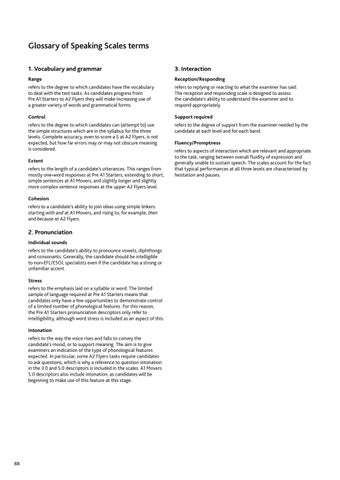Glossary of Speaking Scales terms 1. Vocabulary and grammar
3. Interaction
Range
Reception/Responding
refers to the degree to which candidates have the vocabulary to deal with the test tasks. As candidates progress from Pre A1 Starters to A2 Flyers they will make increasing use of a greater variety of words and grammatical forms.
refers to replying or reacting to what the examiner has said. The reception and responding scale is designed to assess the candidate’s ability to understand the examiner and to respond appropriately.
Control
Support required
refers to the degree to which candidates can (attempt to) use the simple structures which are in the syllabus for the three levels. Complete accuracy, even to score a 5 at A2 Flyers, is not expected, but how far errors may or may not obscure meaning is considered.
refers to the degree of support from the examiner needed by the candidate at each level and for each band.
Extent refers to the length of a candidate’s utterances. This ranges from mostly one-word responses at Pre A1 Starters, extending to short, simple sentences at A1 Movers, and slightly longer and slightly more complex sentence responses at the upper A2 Flyers level. Cohesion refers to a candidate’s ability to join ideas using simple linkers: starting with and at A1 Movers, and rising to, for example, then and because at A2 Flyers.
2. Pronunciation Individual sounds refers to the candidate’s ability to pronounce vowels, diphthongs and consonants. Generally, the candidate should be intelligible to non-EFL/ESOL specialists even if the candidate has a strong or unfamiliar accent. Stress refers to the emphasis laid on a syllable or word. The limited sample of language required at Pre A1 Starters means that candidates only have a few opportunities to demonstrate control of a limited number of phonological features. For this reason, the Pre A1 Starters pronunciation descriptors only refer to intelligibility, although word stress is included as an aspect of this. Intonation refers to the way the voice rises and falls to convey the candidate’s mood, or to support meaning. The aim is to give examiners an indication of the type of phonological features expected. In particular, some A2 Flyers tasks require candidates to ask questions, which is why a reference to question intonation in the 3.0 and 5.0 descriptors is included in the scales. A1 Movers 5.0 descriptors also include intonation, as candidates will be beginning to make use of this feature at this stage.
88
Fluency/Promptness refers to aspects of interaction which are relevant and appropriate to the task, ranging between overall fluidity of expression and generally unable to sustain speech. The scales account for the fact that typical performances at all three levels are characterised by hesitation and pauses.

